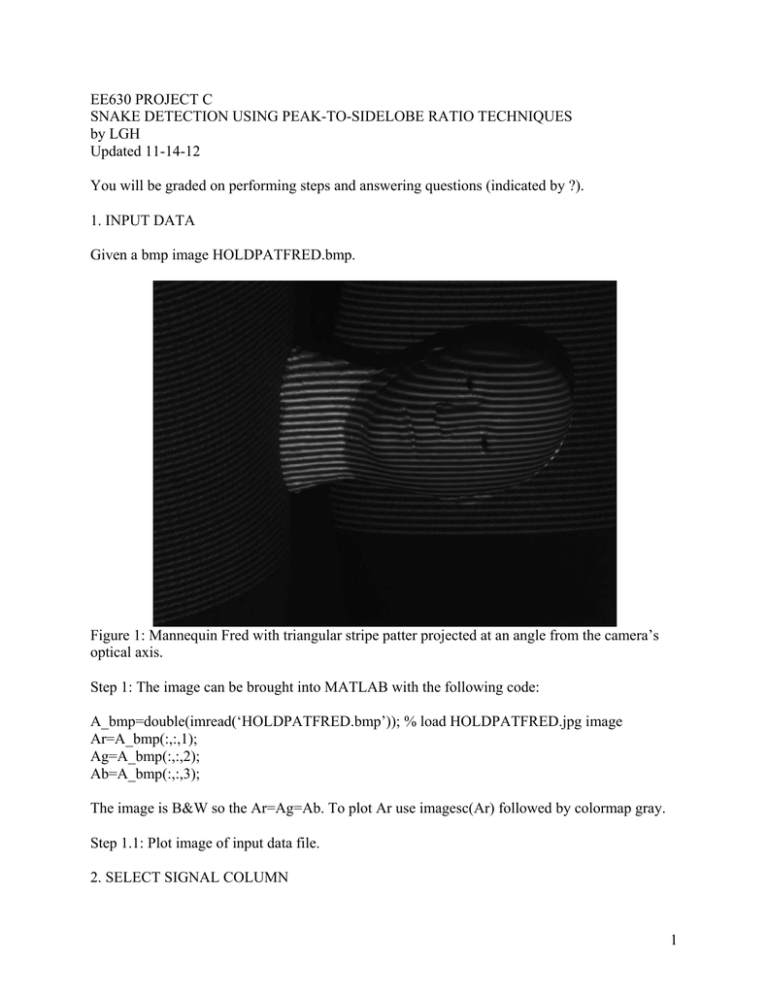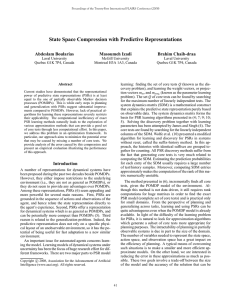EE630 PROJECT C SNAKE DETECTION USING PEAK-TO-SIDELOBE RATIO TECHNIQUES by LGH Updated 11-14-12
advertisement

EE630 PROJECT C SNAKE DETECTION USING PEAK-TO-SIDELOBE RATIO TECHNIQUES by LGH Updated 11-14-12 You will be graded on performing steps and answering questions (indicated by ?). 1. INPUT DATA Given a bmp image HOLDPATFRED.bmp. Figure 1: Mannequin Fred with triangular stripe patter projected at an angle from the camera’s optical axis. Step 1: The image can be brought into MATLAB with the following code: A_bmp=double(imread(‘HOLDPATFRED.bmp’)); % load HOLDPATFRED.jpg image Ar=A_bmp(:,:,1); Ag=A_bmp(:,:,2); Ab=A_bmp(:,:,3); The image is B&W so the Ar=Ag=Ab. To plot Ar use imagesc(Ar) followed by colormap gray. Step 1.1: Plot image of input data file. 2. SELECT SIGNAL COLUMN 1 Step 2.1: Select and plot, the nx column to represent a signal. Indicate which nx you used. The size of the image is [My Nx]=size(Ar); A 1-D vector would be My by 1. sc=Ar(1:My,nx); Figure 2: The middle column intensity of Fig. 1. 3. POSITIVE PEAK DETECTION USING PEAK TO SIDE LOBE RATIO A peak-to-sidelobe ratio (PSR) can be used to identify the positive peak locations of the signal in Fig. 2. The PSR is albedo invariant because it is a ratio, thereby canceling the multiplicative factors of albedo and reflected light. There are two approaches to the PSR. One is based on a linear acquisition of the sidelobe intensities and the other on an ordered one. For the linear approach the PSR is determined from PSR1 n, 2 I [ n] I n I n (1) It should be noted that the published convention for PSR1 is the square of the peak divided by the square of the sidelobe value. Because we are implementing this technique, it is numerically more efficient to use the non-squared version in Eq. (1). The ordered PSR2 represents the worst case scenario by using the greater of the two sidelobes such that PSR2 n, I [ n] maxI n , I n (2) 2 3a. Use the PSR’s in Eqs (1) and (2) to process the signal in Fig. 2. Plot their responses on the same graph along with the input signal and scale to maximum value in Fig. 2. Optimize a threshold and the sidelobe spacing to most accurately determine the peak positions. One way to do this manually is to over adjust the parameter both high and low, then take the value in between, as optimum. Search segments containing values above , for the peak location and plot the peak locations only so that it is easy to see the alignment of the peaks with the original signal column. Given these optimum values, try the PSRs on all the columns in the entire image. Plot these two results. Encode PSR peaks as 255, and 128 for non-peak PSRs greater than and 0 for PSRs below . 3b. Using the PSR of your choice, determine the range of where min will yield high PSR for the highest frequency stripes and max will yield best results for the low pattern frequencies. Then, by incrementing between min and max by Dt such that there are 5 different PSR images of Fig. 1. Then for each pixel select the maximum PSR from the 5 images and display result in a single image. You should see a result better than any single value. Comment on your results. 4. PREFILTER FOR IMPROVED PSR PEAK LOCATION Run a 3x3 rectangular moving average filter on the image before performing the PSR. Then repeat section 3 and compare the resulting peak detection with section 3. Plot the signal column of pre-filtered data on top of non-pre-filtered data. 5. DOWN SAMPLE FOLLOWED BY UP SAMPLING Instead of pre-filtering the full resolution image, try down sampling by 2 and then up sample by 2. The down sampling is not just simply throwing away ever other pixel. Try averaging each down sampled pixel with its original adjacent pixel average. That is I d 2 [ n] 1 1 1 I 2n 1 I 2n I 2n 1 4 2 4 (3) Normally, the result in Eq. (3) would have additional processing performed thereby decreasing the number of total pixels by 2 per dimension. For this example, let’s just upsample by 2 such that I d 2 n / 2 for n even I 2 x n I d2 n 1 / 2 I d2 n 1 / 2 / 2 for n odd (4) Perform the PSR peak detection process and compare the signal column with the prefiltered technique. Give a qualitative description of whether you think it is better, the same or worse in performance. 6. PROCESS FULL IMAGE FOR POSITIVE “SNAKES” Process the full input images and mark out all PSR peak locations. If the display process dithers the result, put a 128 on either side, top and bottom, of the peak location. This way, the “snake” 3 will be visible for the whole image. Use the method that you think is the best and indicate which method you used. 4







